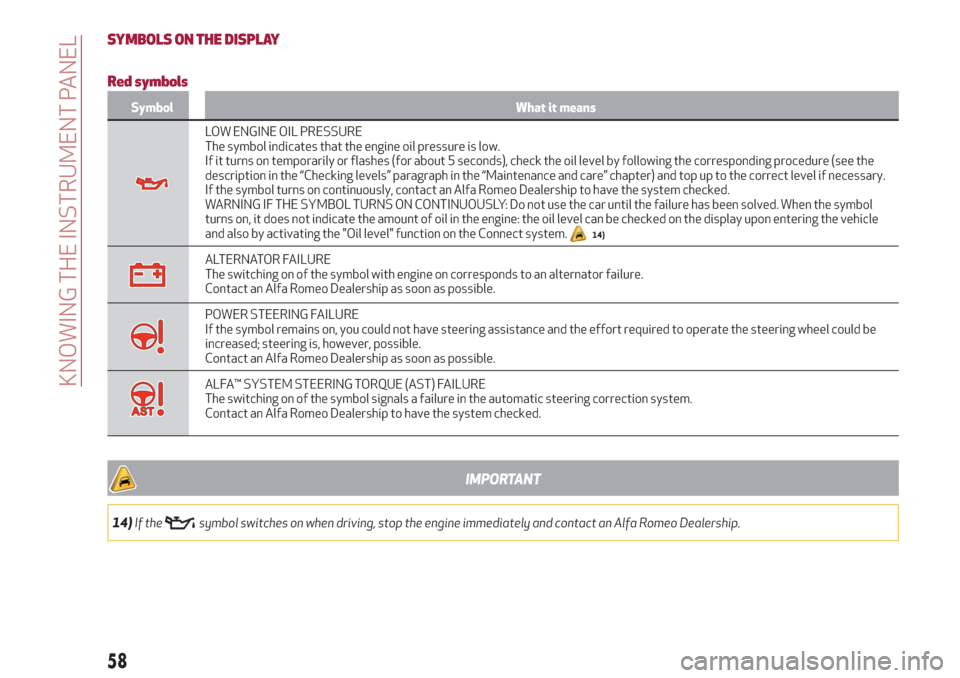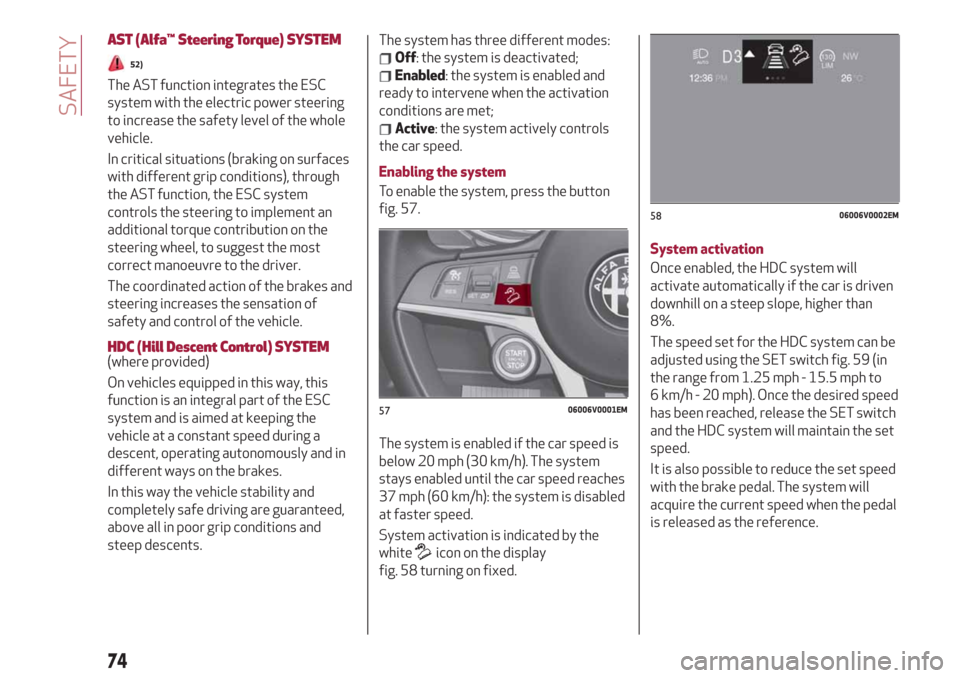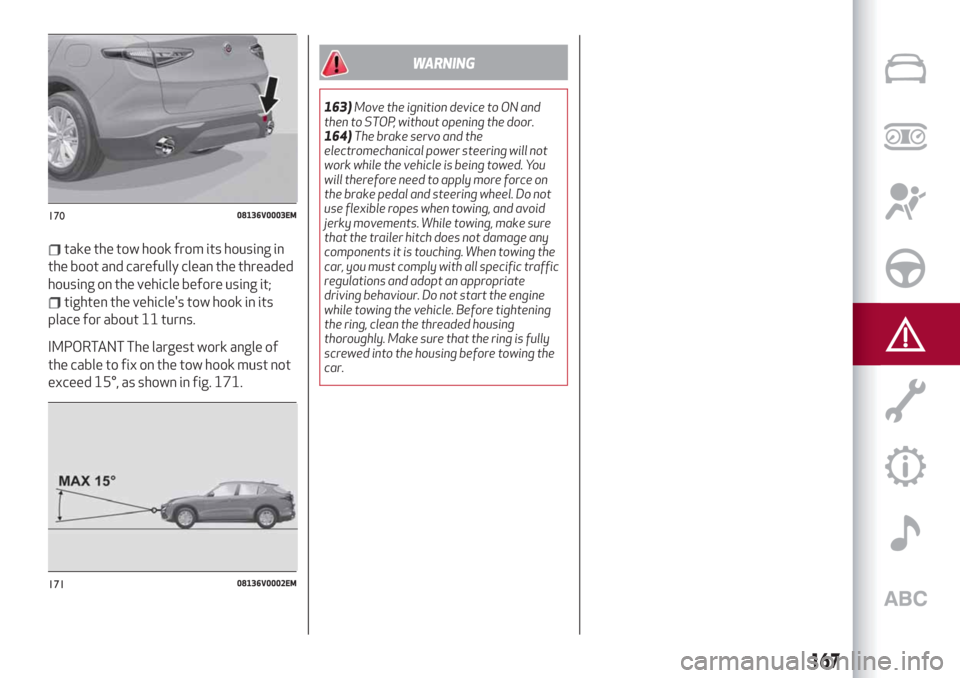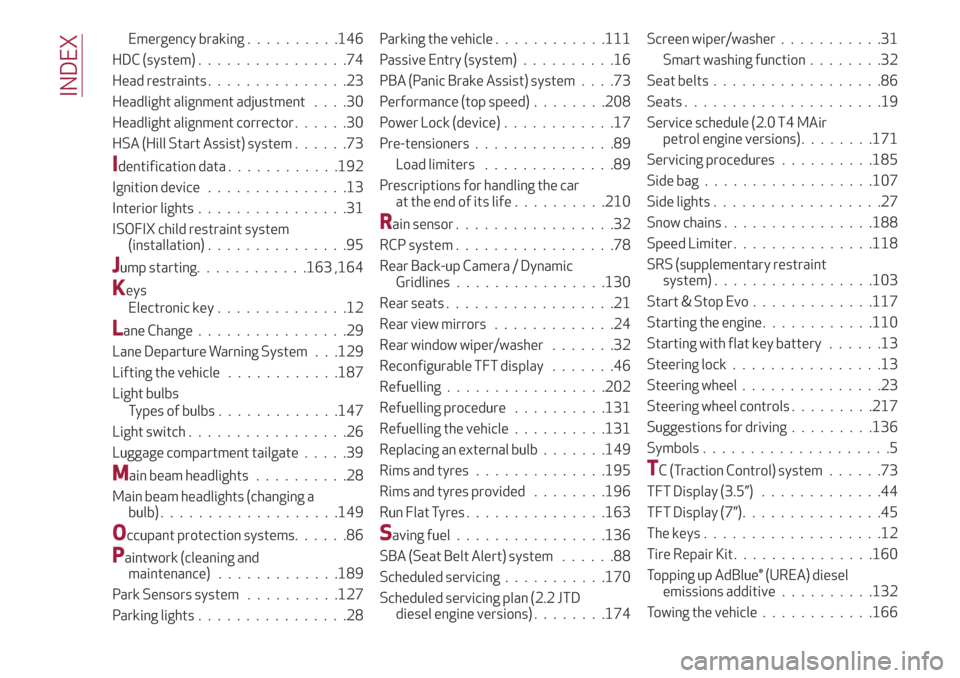power steering Alfa Romeo Stelvio 2019 Owner's Manual
[x] Cancel search | Manufacturer: ALFA ROMEO, Model Year: 2019, Model line: Stelvio, Model: Alfa Romeo Stelvio 2019Pages: 244, PDF Size: 4.95 MB
Page 60 of 244

SYMBOLS ON THE DISPLAY
Red symbols
Symbol What it means
LOW ENGINE OIL PRESSURE
The symbol indicates that the engine oil pressure is low.
If it turns on temporarily or flashes (for about 5 seconds), check the oil level by following the corresponding procedure (see the
description in the “Checking levels” paragraph in the “Maintenance and care” chapter) and top up to the correct level if necessary.
If the symbol turns on continuously, contact an Alfa Romeo Dealership to have the system checked.
WARNING IF THE SYMBOL TURNS ON CONTINUOUSLY: Do not use the car until the failure has been solved. When the symbol
turns on, it does not indicate the amount of oil in the engine: the oil level can be checked on the display upon entering the vehicle
and also by activating the "Oil level" function on the Connect system.
14)
ALTERNATOR FAILURE
The switching on of the symbol with engine on corresponds to an alternator failure.
Contact an Alfa Romeo Dealership as soon as possible.
POWER STEERING FAILURE
If the symbol remains on, you could not have steering assistance and the effort required to operate the steering wheel could be
increased; steering is, however, possible.
Contact an Alfa Romeo Dealership as soon as possible.
ALFA™ SYSTEM STEERING TORQUE (AST) FAILURE
The switching on of the symbol signals a failure in the automatic steering correction system.
Contact an Alfa Romeo Dealership to have the system checked.
IMPORTANT
14)If thesymbol switches on when driving, stop the engine immediately and contact an Alfa Romeo Dealership.
58
KNOWING THE INSTRUMENT PANEL
Page 75 of 244

turning more than it should according to
the angle of the steering wheel.
Understeer: occurs when the vehicle is
turning less than it should according to
the angle of the steering wheel.
System intervention
The intervention of the system is
indicated by the flashing of the ESC
warning light on the instrument panel, to
inform the driver that the vehicle
stability and grip are critical.
37) 38) 39) 40) 41)
TC (Traction Control)SYSTEM
The system automatically operates in the
event of slipping, loss of grip on wet
roads (aquaplaning) and acceleration on
slippery, snowy or icy roads, etc. on one
or both drive wheels. Depending on the
slipping conditions, two different control
systems are activated:
if the slipping involves both drive
wheels, the system intervenes, reducing
the power transmitted by the engine;
if the slipping only involves one of the
drive wheels, the BLD (Brake Limited
Differential) function is activated,
automatically braking the wheel which is
slipping (the behaviour of a self-locking
differential is simulated). This will
increase the engine torque transferred to
the wheel which isn't slipping.System intervention
The intervention of the system is
indicated by the flashing of the ESC
warning light on the instrument panel, to
inform the driver that the vehicle
stability and grip are critical.
42) 43) 44) 45) 46)
PBA (Panic Brake Assist)SYSTEM
The PBA system is designed to improve
the vehicle’s braking capacity during
emergency braking.
The system detects emergency braking
by monitoring the speed and force with
which the brake pedal is pressed, and
consequently applies the optimal brake
pressure. This can reduce the braking
distance: the PBA system therefore
complements the ABS.
Maximum assistance from the PBA
system is obtained by pressing the brake
pedal very quickly. In addition, the brake
pedal should be pressed continuously
during braking, avoiding intermittent
presses, to get the most out of the
system. Do not reduce pressure on the
brake pedal until braking is no longer
necessary.
The PBA system is deactivated when the
brake pedal is released.
47) 48) 49)
HSA (Hill Start Assist)SYSTEM
This is an integral part of the ESC system
and facilitates starting on slopes,
activating automatically in the following
cases:
uphill: vehicle stationary on a road
with a gradient higher than 5%, engine
running, brake pressed and transmission
in neutral or gear other than reverse
engaged;
downhill: vehicle stationary on a road
with a gradient higher than 5%, engine
running, brake pressed and reverse gear
engaged.
When setting off, the ESC system control
unit maintains the braking pressure on
the wheels until the engine torque
necessary for starting is reached, or in
any case for a maximum of 2 seconds,
allowing your right foot to be moved
easily from the brake pedal to the
accelerator.
When two seconds have elapsed, without
starting, the system is automatically
deactivated, gradually releasing the
braking pressure. During this release
stage it is possible to hear a typical
mechanical brake release noise,
indicating the imminent movement of the
car.
50) 51)
73
Page 76 of 244

AST (Alfa™ Steering Torque)SYSTEM
52)
The AST function integrates the ESC
system with the electric power steering
to increase the safety level of the whole
vehicle.
In critical situations (braking on surfaces
with different grip conditions), through
the AST function, the ESC system
controls the steering to implement an
additional torque contribution on the
steering wheel, to suggest the most
correct manoeuvre to the driver.
The coordinated action of the brakes and
steering increases the sensation of
safety and control of the vehicle.
HDC (Hill Descent Control)SYSTEM(where provided)
On vehicles equipped in this way, this
function is an integral part of the ESC
system and is aimed at keeping the
vehicle at a constant speed during a
descent, operating autonomously and in
different ways on the brakes.
In this way the vehicle stability and
completely safe driving are guaranteed,
above all in poor grip conditions and
steep descents.The system has three different modes:
Off: the system is deactivated;
Enabled: the system is enabled and
ready to intervene when the activation
conditions are met;
Active: the system actively controls
the car speed.
Enabling the system
To enable the system, press the button
fig. 57.
The system is enabled if the car speed is
below 20 mph (30 km/h). The system
stays enabled until the car speed reaches
37 mph (60 km/h): the system is disabled
at faster speed.
System activation is indicated by the
white
icon on the display
fig. 58 turning on fixed.System activation
Once enabled, the HDC system will
activate automatically if the car is driven
downhill on a steep slope, higher than
8%.
The speed set for the HDC system can be
adjusted using the SET switch fig. 59 (in
the range from 1.25 mph - 15.5 mph to
6 km/h - 20 mph). Once the desired speed
has been reached, release the SET switch
and the HDC system will maintain the set
speed.
It is also possible to reduce the set speed
with the brake pedal. The system will
acquire the current speed when the pedal
is released as the reference.
5706006V0001EM
5806006V0002EM
74
SAFETY
Page 169 of 244

take the tow hook from its housing in
the boot and carefully clean the threaded
housing on the vehicle before using it;
tighten the vehicle's tow hook in its
place for about 11 turns.
IMPORTANT The largest work angle of
the cable to fix on the tow hook must not
exceed 15°, as shown in fig. 171.
WARNING
163)Move the ignition device to ON and
then to STOP, without opening the door.
164)The brake servo and the
electromechanical power steering will not
work while the vehicle is being towed. You
will therefore need to apply more force on
the brake pedal and steering wheel. Do not
use flexible ropes when towing, and avoid
jerky movements. While towing, make sure
that the trailer hitch does not damage any
components it is touching. When towing the
car, you must comply with all specific traffic
regulations and adopt an appropriate
driving behaviour. Do not start the engine
while towing the vehicle. Before tightening
the ring, clean the threaded housing
thoroughly. Make sure that the ring is fully
screwed into the housing before towing the
car.
17008136V0003EM
17108136V0002EM
167
Page 240 of 244

Emergency braking..........146
HDC (system)................74
Head restraints...............23
Headlight alignment adjustment....30
Headlight alignment corrector......30
HSA (Hill Start Assist) system......73
Identification data............192
Ignition device...............13
Interior lights................31
ISOFIX child restraint system
(installation)...............95
Jump starting............163 ,164
Keys
Electronic key..............12
Lane Change................29
Lane Departure Warning System . . .129
Lifting the vehicle............187
Light bulbs
Types of bulbs.............147
Light switch.................26
Luggage compartment tailgate.....39
Main beam headlights..........28
Main beam headlights (changing a
bulb)...................149
Occupant protection systems......86
Paintwork (cleaning and
maintenance).............189
Park Sensors system..........127
Parking lights................28Parking the vehicle............111
Passive Entry (system)..........16
PBA (Panic Brake Assist) system....73
Performance (top speed)........208
Power Lock (device)............17
Pre-tensioners...............89
Load limiters..............89
Prescriptions for handling the car
at the end of its life..........210
Rain sensor.................32
RCP system.................78
Rear Back-up Camera / Dynamic
Gridlines................130
Rear seats..................21
Rear view mirrors.............24
Rear window wiper/washer.......32
Reconfigurable TFT display.......46
Refuelling.................202
Refuelling procedure..........131
Refuelling the vehicle..........131
Replacing an external bulb.......149
Rims and tyres..............195
Rims and tyres provided........196
Run Flat Tyres...............163
Saving fuel................136
SBA (Seat Belt Alert) system......88
Scheduled servicing...........170
Scheduled servicing plan (2.2 JTD
diesel engine versions)........174Screen wiper/washer...........31
Smart washing function........32
Seat belts..................86
Seats.....................19
Service schedule (2.0 T4 MAir
petrol engine versions)........171
Servicing procedures..........185
Side bag..................107
Side lights..................27
Snow chains................188
Speed Limiter . ..............118
SRS (supplementary restraint
system).................103
Start & Stop Evo.............117
Starting the engine............110
Starting with flat key battery......13
Steering lock . . ..............13
Steering wheel...............23
Steering wheel controls .........217
Suggestions for driving .........136
Symbols....................5
TC (Traction Control) system......73
TFT Display (3.5”) . ............44
TFT Display (7”)...............45
The keys...................12
Tire Repair Kit . ..............160
Topping up AdBlue® (UREA) diesel
emissions additive..........132
Towing the vehicle . ...........166
INDEX